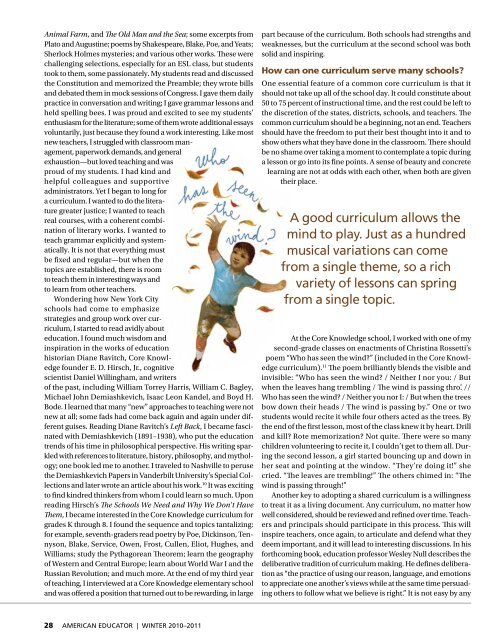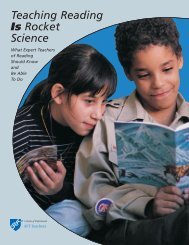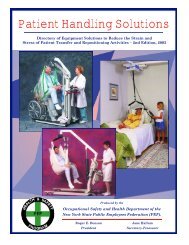American Educator, Winter 2010-11, Vol. 34, No. 4, AFT
American Educator, Winter 2010-11, Vol. 34, No. 4, AFT
American Educator, Winter 2010-11, Vol. 34, No. 4, AFT
You also want an ePaper? Increase the reach of your titles
YUMPU automatically turns print PDFs into web optimized ePapers that Google loves.
Animal Farm, and The Old Man and the Sea; some excerpts from<br />
Plato and Augustine; poems by Shakespeare, Blake, Poe, and Yeats;<br />
Sherlock Holmes mysteries; and various other works. These were<br />
challenging selections, especially for an ESL class, but students<br />
took to them, some passionately. My students read and discussed<br />
the Constitution and memorized the Preamble; they wrote bills<br />
and debated them in mock sessions of Congress. I gave them daily<br />
practice in conversation and writing; I gave grammar lessons and<br />
held spelling bees. I was proud and excited to see my students’<br />
enthusiasm for the literature; some of them wrote additional essays<br />
voluntarily, just because they found a work interesting. Like most<br />
new teachers, I struggled with classroom management,<br />
paperwork demands, and general<br />
exhaustion—but loved teaching and was<br />
proud of my students. I had kind and<br />
helpful colleagues and supportive<br />
administrators. Yet I began to long for<br />
a curriculum. I wanted to do the literature<br />
greater justice; I wanted to teach<br />
real courses, with a coherent combination<br />
of literary works. I wanted to<br />
teach grammar explicitly and systematically.<br />
It is not that everything must<br />
be fixed and regular—but when the<br />
topics are established, there is room<br />
to teach them in interesting ways and<br />
to learn from other teachers.<br />
Wondering how New York City<br />
schools had come to emphasize<br />
strategies and group work over curriculum,<br />
I started to read avidly about<br />
education. I found much wisdom and<br />
inspiration in the works of education<br />
historian Diane Ravitch, Core Knowledge<br />
founder E. D. Hirsch, Jr., cognitive<br />
scientist Daniel Willingham, and writers<br />
of the past, including William Torrey Harris, William C. Bagley,<br />
Michael John Demiashkevich, Isaac Leon Kandel, and Boyd H.<br />
Bode. I learned that many “new” approaches to teaching were not<br />
new at all; some fads had come back again and again under different<br />
guises. Reading Diane Ravitch’s Left Back, I became fascinated<br />
with Demiashkevich (1891–1938), who put the education<br />
trends of his time in philosophical perspective. His writing sparkled<br />
with references to literature, history, philosophy, and mythology;<br />
one book led me to another. I traveled to Nashville to peruse<br />
the Demiashkevich Papers in Vanderbilt University’s Special Collections<br />
and later wrote an article about his work. 10 It was exciting<br />
to find kindred thinkers from whom I could learn so much. Upon<br />
reading Hirsch’s The Schools We Need and Why We Don’t Have<br />
Them, I became interested in the Core Knowledge curriculum for<br />
grades K through 8. I found the sequence and topics tantalizing:<br />
for example, seventh-graders read poetry by Poe, Dickinson, Tennyson,<br />
Blake, Service, Owen, Frost, Cullen, Eliot, Hughes, and<br />
Williams; study the Pythagorean Theorem; learn the geography<br />
of Western and Central Europe; learn about World War I and the<br />
Russian Revolution; and much more. At the end of my third year<br />
of teaching, I interviewed at a Core Knowledge elementary school<br />
and was offered a position that turned out to be rewarding, in large<br />
28 AMERICAN EDUCATOR | WINTER <strong>2010</strong>–20<strong>11</strong><br />
part because of the curriculum. Both schools had strengths and<br />
weaknesses, but the curriculum at the second school was both<br />
solid and inspiring.<br />
How can one curriculum serve many schools?<br />
One essential feature of a common core curriculum is that it<br />
should not take up all of the school day. It could constitute about<br />
50 to 75 percent of instructional time, and the rest could be left to<br />
the discretion of the states, districts, schools, and teachers. The<br />
common curriculum should be a beginning, not an end. Teachers<br />
should have the freedom to put their best thought into it and to<br />
show others what they have done in the classroom. There should<br />
be no shame over taking a moment to contemplate a topic during<br />
a lesson or go into its fine points. A sense of beauty and concrete<br />
learning are not at odds with each other, when both are given<br />
their place.<br />
A good curriculum allows the<br />
mind to play. Just as a hundred<br />
musical variations can come<br />
from a single theme, so a rich<br />
variety of lessons can spring<br />
from a single topic.<br />
At the Core Knowledge school, I worked with one of my<br />
second-grade classes on enactments of Christina Rossetti’s<br />
poem “Who has seen the wind?” (included in the Core Knowledge<br />
curriculum). <strong>11</strong> The poem brilliantly blends the visible and<br />
invisible: “Who has seen the wind? / Neither I nor you: / But<br />
when the leaves hang trembling / The wind is passing thro’. //<br />
Who has seen the wind? / Neither you nor I: / But when the trees<br />
bow down their heads / The wind is passing by.” One or two<br />
students would recite it while four others acted as the trees. By<br />
the end of the first lesson, most of the class knew it by heart. Drill<br />
and kill? Rote memorization? <strong>No</strong>t quite. There were so many<br />
children volunteering to recite it, I couldn’t get to them all. During<br />
the second lesson, a girl started bouncing up and down in<br />
her seat and pointing at the window. “They’re doing it!” she<br />
cried. “The leaves are trembling!” The others chimed in: “The<br />
wind is passing through!”<br />
Another key to adopting a shared curriculum is a willingness<br />
to treat it as a living document. Any curriculum, no matter how<br />
well considered, should be reviewed and refined over time. Teachers<br />
and principals should participate in this process. This will<br />
inspire teachers, once again, to articulate and defend what they<br />
deem important, and it will lead to interesting discussions. In his<br />
forthcoming book, education professor Wesley Null describes the<br />
deliberative tradition of curriculum making. He defines deliberation<br />
as “the practice of using our reason, language, and emotions<br />
to appreciate one another’s views while at the same time persuading<br />
others to follow what we believe is right.” It is not easy by any





